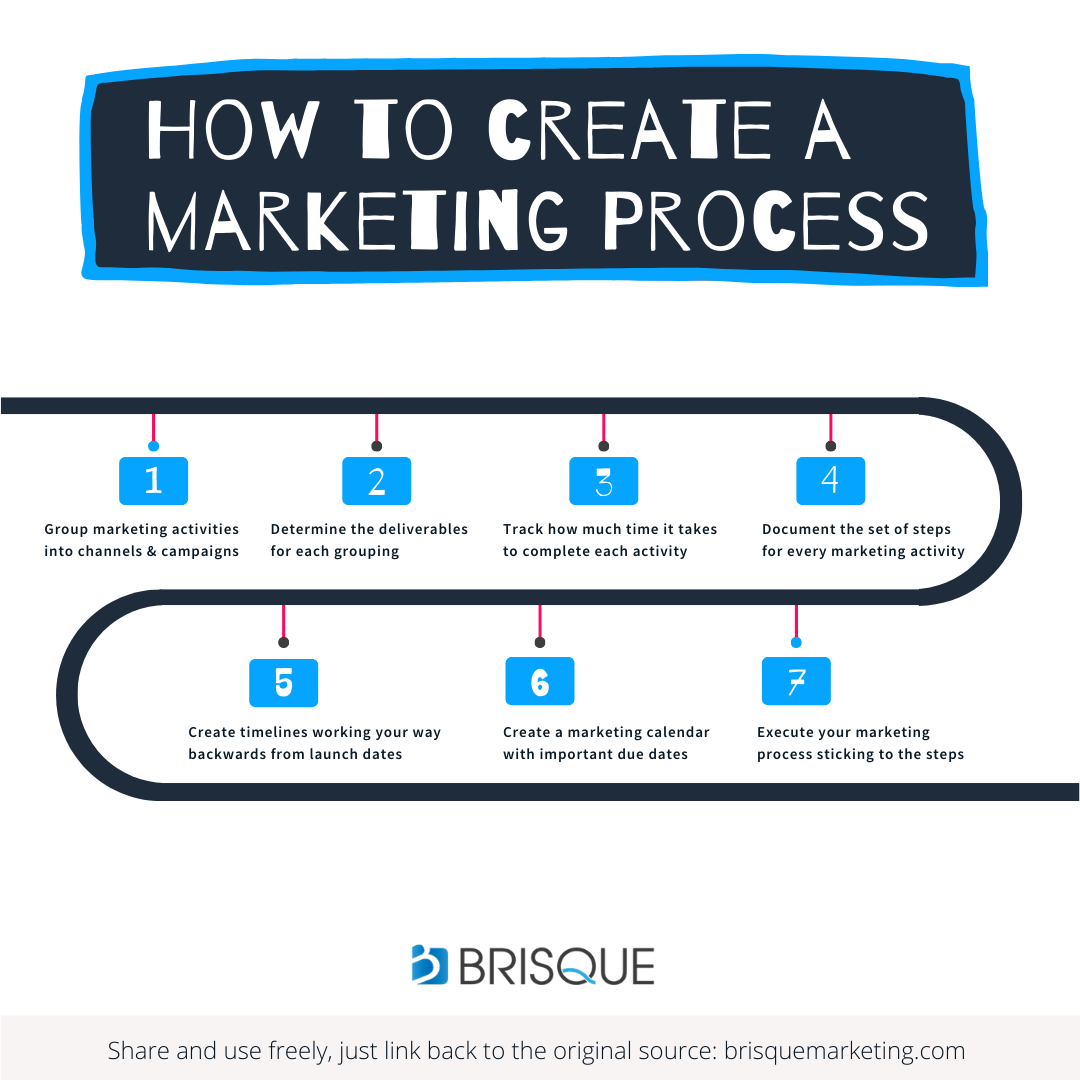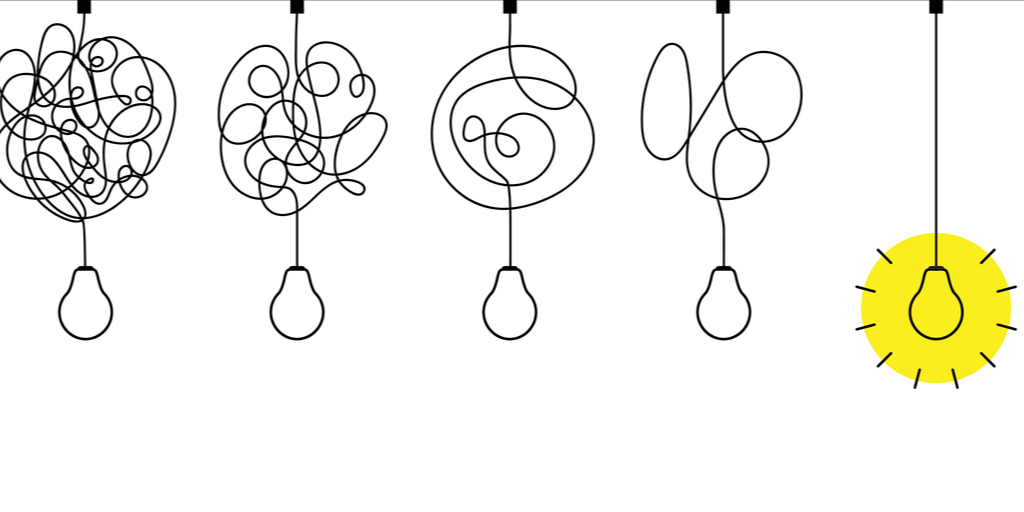As a junior marketer, life was simple.
I had assigned tasks; I completed the tasks to the best of my ability, and that was it. I didn’t have to worry so much about what happened next. When I started leading marketing teams, I realized that if you wanted to track what’s happening and improve results, you need to follow a system.
The marketing system that you create doesn’t have to be rigid.
You just have to have a set of steps that you perform in a certain way to ensure that you can achieve consistent results. Without a marketing process, you can kiss following your marketing plan goodbye.
In this post, I share marketing process tips that I’ve learned along the way. Before we dive into that, let’s look at what a marketing process is.
What is a Marketing Process?
A marketing process is a set of steps and actions to execute marketing tasks based on a marketing plan. A marketing process often consists of multiple activities tied to marketing campaigns or specific deliverables (tangible outcomes). Then, you execute your marketing activities using specific channels or mediums.
Read Also: How to Create a Marketing Roadmap

Here are a few lessons that I learned from building marketing processes
1. Ensure that your entire marketing team is involved in the process creation
Sometimes you must create the process then explain or mentor your team through the marketing process. If you have a more experienced team, you can delegate the process creation task. Have each team lead come up with their strategy for managing their team tasks and projects. In turn, you get more internal buy-in than when you don’t put the team leads in charge.
Related: Ready to Go Beyond Word-of-Mouth Marketing? Here’s What to Do Next
2. Plan for disruptions
I used to have a full marketing team calendar because I felt like we needed to maximize our time.
That thinking turned out to be flawed because it’s life!
Things will come up that you don’t anticipate. To help combat this, you want to build disruptions into your plan.
Here’s how you build disruptions into your process
So, let’s say your team can technically execute your marketing plan if they are operating at 85% capacity.
And I say 85% capacity because most humans cannot operate at 100% capacity (they have to rest, take potty breaks, answer emails, and sometimes just daydream and not be as productive).
Essentially, you want to take into account ad hoc activities that may come up. In that case, you want to subtract at least 15% from the 85% capacity, leaving your team operating at a 70% capacity.
Therefore, you would adjust your teams’ goals and activities planned accordingly. If you were planning ten campaigns at 85% capacity, you might need to scale back to 8 to make room for other activities that may come up later.
Read: Brand Strategy vs. Marketing Strategy vs. Marketing Activity: What Is The Difference?
3. Marketing Deliverables! Deliverables! Deliverables!
Your marketing process needs to work towards a marketing deliverable.
It makes the steps feel like you are working towards having something tangible to attribute to the actions taken. It doesn’t have to be anything major it could be a newsletter deliverable that has a process of:
- Having a newsletter meeting with teams to decide what to include
- Creating first draft of the newsletter
- Have the team review the first draft of the newsletter
- Create a finalized version of the newsletter
- Schedule the newsletter to go out
- Review results from newsletter a week after delivery and note areas of improvement or what worked well.
Related: The Real Reason Why You Are Not Building a Scalable Marketing Process
4. Track Your Project Time
You can create a repeatable process if you estimate how long it will take to execute specific tasks.
I personally don’t like to be micromanaged or micromanage others, so the easiest way to track time is based on the number of days it takes to complete a deliverable. Back to my newsletter project example, it may take a person about an hour or two to design the newsletter.
Rather than tracking the time at the granular level (hours), I like to know how much time something takes in days. For instance, if the only work you did in a day on the newsletter was for 2 hours, and then you went on to work on other tasks that are not related to the newsletter, I would still count that as a day.
In the end, I like to know the number of days instead of hours because I believe it gives people the flexibility to plan out their workdays as they see fit.
Additionally, it also offers a bit of a buffer to allow people to make up for the time if they go off track because they were attending to something else.
Read: How to Evaluate Creative Marketing Strategies or Ideas
5. Grouping tasks will save you a lot of time
Once you have a process in place, you want to make sure that you group similar tasks into one step if possible. If you are editing a blog, you can also make on-page SEO changes to the blog. When you finish the editing process, you’ll have a blog post that’s optimized.
6. Always know your start and due dates
Due dates for projects are often easy to remember.
When you need to start is what you can miss if you get tied up with something else. When you miss starting dates, you are likely to have to rush through to meet deadlines. As a result, for each marketing process and step, always work your way backward to determine your start date. That way, you can have something planned on your calendar to ensure that you can start on time. It will save you all-nighters and stress later.
Marketing Process Pro Tip: If you plan your start date with a bit of a buffer, you’ll know if you can extend the start date or not.
Try to add +3 days or +1 week. That way, if you happen to work on something else that’s urgent, you can push back the start day a little if needed. When it comes to due dates, you can have two types of due dates:
- Go live dates – that is when things are published; everyone sees it.
- Internal due dates – or dates when tasks need to be completed internally. This also needs to have a buffer to help prevent rushing at the end to meet go-live dates.
Related: How to Figure Out the Type of Marketing Challenge You Have
7. Always Document Your Steps
It may feel like everyone on the team knows what they should do, so there is no need to document your steps or create a working document to track steps. Even if everyone knows, you want to document your steps for two main reasons:
Reason #1: it makes it easier to train teams later on
Reason #2: it might be difficult later on to figure out areas in your steps that cause bottlenecks in your process if you don’t document.
Documenting your steps doesn’t have to be done in any fancy fashion. Use whatever medium you are comfortable with. I tend to prefer using spreadsheets because I can easily make notes and sort the steps as needed. You can also use a project management solution for this.
Read: Creative Ways to Track Branding Campaign Success
8. Follow Your Process
Finally, a marketing process is only a process if you follow it. If you deviate from your process a lot, you won’t end up with a process.
If you want your marketing steps to be a process, you have to follow it as closely as possible. However, it’s not to say that you should become inflexible and rigid. With that said, you should strive to make the times that you stray from your process the exception and not the norm.
Final thoughts on creating a marketing process
Creating a marketing methodology or process that works for your business takes a lot of constant refining and tweaking. There is nothing like a one-and-done marketing process. You have to constantly assess what’s working and what’s not working so that you can do things significantly better each time you execute.





